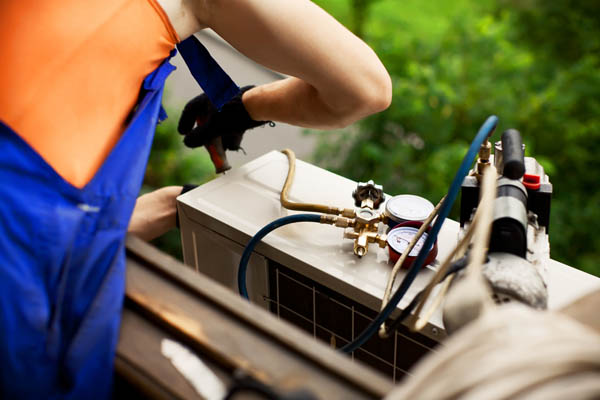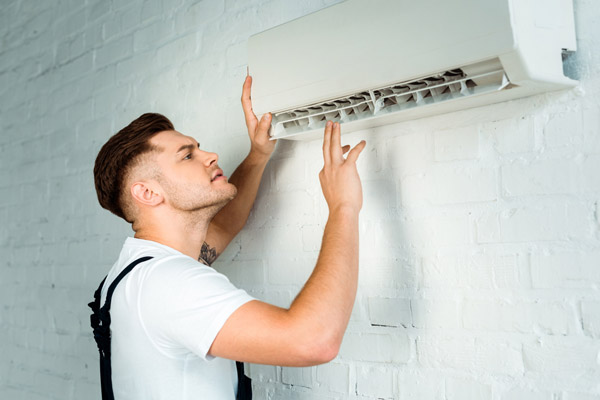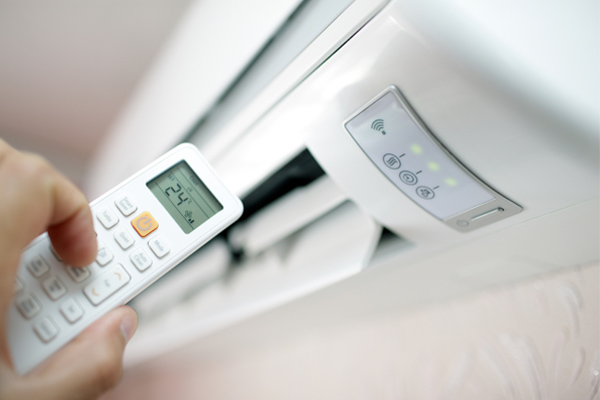
Are you thinking of switching to a ductless mini-split system? Make sure that the unit is the correct size. Ductless mini-split systems are high-efficiency HVAC systems since inverter technology is built into their design. With this technology, mini-splits can generate a specific level of heating or cooling to match your preferred temperature settings. However, even if a mini-split system and a ductless heat pump have inverter technology, it may still not suit your needs if it is sized incorrectly. In this article, we share a ductless mini-split sizing guide to help you out.
What Is Ductless Mini-Split Sizing And Why is It Important?

If you are planning on getting a new HVAC system installed in your home, you and your contractor will have to discuss the proper size. This is to ensure that the system is neither too small nor too big. The same principle holds true with ductless mini-split systems.
A mini-split system that is too small will not be effective in regulating the temperature indoors. If the unit is oversized, on the other hand, it will not be as efficient as it should be and will likely wear out more quickly.
When a mini-split system or a ductless heat pump is correctly sized, you are assured of constant comfort and excellent energy savings. The correct-sized system will be capable of effectively cooling or heating your home. A good way to ensure efficiency and comfort is to install a ductless heat pump system that carries a BTU rating that will match the cooling/heating needs of your home.
What Is A BTU?
BTU stands for British Thermal Unit. It is a unit for measuring thermal energy. BTU is an expression of the amount of heat required to increase the temperature of 1 lb. of water by 1° Fahrenheit.
Generally, larger rooms require a higher BTU rating for your mini-split system. Ductless heat pumps typically come with BTU ratings of about 6,000 to as much as 56,000. When looking for a mini-split and determining your BTU requirements, remember that the heating capacity of these systems should be higher than their cooling capacity.
You should also keep in mind the size of the system. Make sure that the ductless heat pump system is not too big or too small for the space you want to cool or heat. If you choose the wrong size for the unit, you will likely experience discomfort. The overall functionality of the system could also be affected.
What If The Ductless Heat Pump Is Too Small?

If your mini-split system is smaller than the requirement, it will be inefficient, causing temperature deficiencies in your home. You will also notice that your home is not cool or warm enough. Of course, the unit will still work but it will fail to keep indoor space conditioned effectively. As a result, the unit will just consume energy without giving you the full comfort you expect. Due to the small sizing of the HVAC unit, you will experience hot and/or cold spots in certain areas of your home since the unit is not big enough to supply conditioned air to those locations sufficiently.
If the ductless mini-split system is too small, it will also have to work harder to make up for the inadequacy of its heating or cooling capability. As a result, the unit will wear out prematurely. This makes it more prone to early breakdowns. Since it will be working doubly hard, you could also expect higher utility bills.
What If The Ductless Heat Pump Is Too Big?
On the other end of the scale, there’s the bigger mini-split. Some homeowners think that by getting a unit that is bigger than the correct size, they will enjoy better cooling or heating. This, unfortunately, is not true. Since the price is directly proportional to the size and capacity of the unit, you will also pay more for it. Also, since the capacity is bigger, forget about any savings you will have in terms of energy cost.
Another issue with a mini-split system that is oversized is short cycling. This is an issue wherein the unit turns on and turns off repeatedly within short periods. The problem is that it leads to premature wear and tear. When this happens, the system will malfunction and fail.
Mini-splits also work as dehumidifiers. However, if the unit short-cycles frequently, it will not be as effective in removing humidity. As a result, humidity levels in your home will be higher than usual.
Properly Sizing Your Ductless HVAC Systems

There are factors that should be considered when you choose a mini-split system. These factors include:
- The size of your home, room, or space
- Single-zone or multi-zone application
- The size of the outdoor compressor compared to the size of the indoor unit(s)
Room sizes in a home may vary. Some rooms may be bigger than others, for example. Should this be the case in your home, make sure the BTU rating of every air handler matches the heating and cooling needs of your home. If your outdoor compressor is different in size from your indoor units, it should not matter as long as it is complementary to the indoor air handlers.
If you have the knowledge and some experience, you could probably try to compute for the size of the mini-split system for your home. However, to get accurate figures, make sure to work with a professional. An expert HVAC technician often conducts certain steps to calculate the correct size of a mini-split or ductless heat pump. These steps include:
- Determine the size of the rooms per square foot. This is done by measuring the length and the width of the interior space and multiplying these numbers. Let’s say the room is 30 feet in length and 40 feet in width. If you multiply 30 by 40, you have a room that is 1,200 sq. ft. in area.
- Determine the approximate BTU rating. To find the figure, the technician multiplies the room area by 25. Given the example above, we take 1,200 sq. ft. multiplied by 25 and we have the ideal BTU of 30,000.
The method of calculating BTU demonstrated above is best for rectangular rooms. It could also work for circular- and triangular-shaped rooms. If you have an uneven-shaped room, a professional will still be able to calculate the required BTU by determining the area of the room. With this figure, your HVAC technician can then advise you about the exact sizing requirement of your home.
Here is a list of approximate BTU sizing for your mini-split system:
Ductless Mini-Split Sizing Chart
HVAC Load Calculation: Factors To Consider
Other than room size, there are other factors that will affect BTU capacity. Environmental conditions, along with certain external factors can also affect your BTU requirement and ultimately, the size of the mini-split system you need. Some of these factors include:
Climate
Climate can affect indoor temperatures. If you live in areas that experience high or low temperatures, your mini-split system may have to be sized differently. Let’s say your area experiences in excess of 90° Fahrenheit during the hottest months. In this case, the mini-split system you need should be capable of increasing the BTU rating by a minimum of 30% to make it effective.
Age And Insulation
The year your home was built is another key factor to consider before buying. Newer homes, for example, often have better insulation compared to older structures. This is largely due to building codes that have been revised over the years. If you have an older home, it is likely it does not have good insulation and will require more power to heat or cool. As such, you will need a mini-split system that has a BTU rating that is increased by a minimum of 30% to maintain a comfortable indoor temperature. If your home is new and has good insulation, you likely will require a unit with lower BTU.
Ceiling Height
The height of your ceilings will affect the size of the rooms. High ceilings, for example, make the area of your room bigger. In most homes, the average ceiling height is around 8 feet. For homes with higher ceilings of, say, 10 to 15 feet, you will need to increase BTU capacity by a minimum of 20% to ensure sufficient performance.
Other Factors To Consider
There are factors found in your home that must also be considered so you can choose the correct BTU load. These are:
- Doors And Windows: It matters whether or not your doors and windows are properly insulated because this will affect the BTU load. If you have more windows and doors, or if there are cracks and gaps in the joints of the doors and windows, know that this will cause air leaks and will affect the performance of your mini-split system.
- Direct Sunlight: Rooms that receive direct sunlight are generally warmer than other rooms. Consider how many rooms receive direct sunlight and for how many hours so you can determine the correct capacity of your mini-split system.
- Kitchen: If you want a mini-split unit in your kitchen or in a room close to it, you will likely need a bigger-sized unit. Kitchens are generally open spaces that produce heat from stoves and ovens, which means they will require more power from your mini-split system.
- Number Of Occupants: Human bodies generate heat, so the more people there are in your house, the more cooling or heating capacity you will require.
- Lightbulbs: Lighting fixtures will generate heat when turned on, with some types heating up space more than others. If your house has a lot of heat-producing lightbulbs, factor this into your capacity/sizing calculation.
- Floor Type: Any carpeting on the floor is a type of insulation. If you just have hardwood, tile, or stone floors, your mini-split or ductless heat pump will have to work more to produce heat.
Conclusion
The load calculation is the process of determining the correct size of a ductless mini-split system for use in living space. The correct calculation of this figure will ensure that your home and all the spaces in it will receive constant and comfortable warm or cold air.
There are resources on the Internet that allow you to calculate load. However, these do not often include other important factors. If you want more precise calculations, better consult a professional HVAC technician. A qualified expert in the field can ensure that you get the correct figures and the perfect product for your needs.
Call Skylands Energy Service To Learn More About Ductless HVAC Systems
 A ductless system will provide you with low energy costs, increased home comfort, healthy indoor air quality, and safety. If you are ready to switch to a ductless system or have more questions, call Skylands Energy Service right away. Our NATE-certified technicians will discuss your needs and requirements to help you find the best ductless HVAC system setup for your home. We offer a range of heating and cooling services, including installations, repairs, replacements maintenance, and more. We also provide free in-home estimates. Call Skylands Energy Service today.
A ductless system will provide you with low energy costs, increased home comfort, healthy indoor air quality, and safety. If you are ready to switch to a ductless system or have more questions, call Skylands Energy Service right away. Our NATE-certified technicians will discuss your needs and requirements to help you find the best ductless HVAC system setup for your home. We offer a range of heating and cooling services, including installations, repairs, replacements maintenance, and more. We also provide free in-home estimates. Call Skylands Energy Service today.
Contact us now at (908) 707-1776 to find out more!
The post Ductless Mini-Split Sizing Guide appeared first on Skylands Energy.
from Skylands Energy https://www.skylandsenergy.com/hvac/ductless-mini-split-sizing-guide
via IFTTT

No comments:
Post a Comment